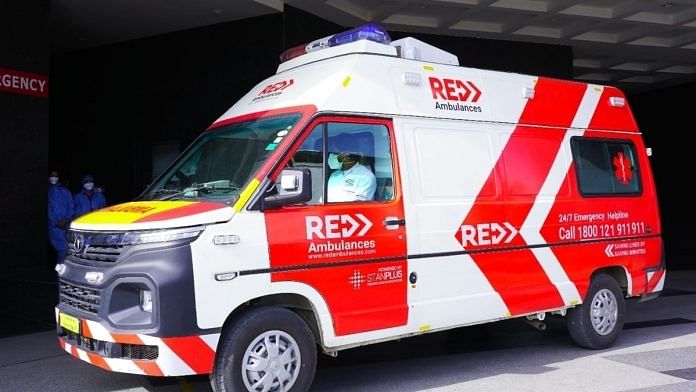New Delhi: Restaurant aggregator Zomato’s announcement of a 10-minute food delivery service last week drew many negative reactions, with some saying that what India really needed was a 10-minute ambulance service. Now, a Hyderabad-based medical emergency response platform is aiming to do that, in eight minutes flat.
StanPlus, with its fleet of over 3,000 ambulances, currently promises to answer emergency calls within six seconds and provide ambulances to patients within 15 minutes. Having secured a fresh round of $20 million funding in January, the company’s founder and chief executive Prabhdeep Singh is now trying to reduce the ambulance arrival time to eight minutes.
Speaking to ThePrint, Singh recalled how helpless he felt when he was out of the country and his parents faced a medical emergency. “A lot of us have been in such situations. We often do not know how to respond, whom to call, or even where the nearest hospital is,” he said.
“The major problem in cities is that people often call the hospital for the ambulance, and most of the time that is not the nearest hospital. That is why the ambulance takes so long,” he added.
In 2015, while working with the cardiology division of a pharmaceutical company, Singh understood that there is huge demand for such an ambulance service. “People spend a crazy amount of money trying to secure themselves an ambulance,” he said.
Currently, StanPlus offers its services in Hyderabad, Bengaluru, Raipur, Bhubaneswar, Ahmedabad and Kolkata. It plans to expand to 10 more Indian cities soon, including Kanpur, Lucknow, Mumbai and Pune.
Its fleet of ambulances includes those run by the company itself, as well as other ambulance services as partners. “In future, to scale up services, we will look at partnering with governments,” Singh said.
Also read: 10-minute Zomato delivery is a great idea, provided you don’t have many expectations
‘Combining tech with care’
Singh pointed out that the demand is for emergency management and response as a whole, and running an ambulance service is just one part of it. He said there are three components to responding to a medical emergency outside a hospital — understanding what is wrong, providing immediate first aid or treatment, and then transport.
“Our service has products on all three verticals. The service starts from answering the call. We combine tech with care,” he said.
Asked how the service can tackle unforeseen challenges on the road, such as traffic, Singh said traffic is not the biggest hurdle in getting the ambulance to reach on time. Rather, the problem is people selecting the wrong destination.
People don’t call for professional help, rather they call a well-known hospital that may be 25 minutes away. New York City is often as congested, but ambulance time there is shorter because the 911 service is centralised, he pointed out.
“Our hope is to become the 911 service for India, where a person can call and tell us the emergency and the kind of insurance they have, and we send the nearest ambulance to take them to the nearest hospital,” Singh said.
According to Singh, the way this service will work is through partnerships with employers or event managers, so that an individual does not have to bear the cost of the ambulance.
“We will generate a dedicated helpline number for the staff of a company. In case of an emergency, the staff will know which number to call to get help to their office, for example,” Singh explained.
Currently, the cost of the ambulance ride is borne either by the hospital or employers who sign up for the service for their staff. An individual does not bear the cost.
“We do not want the individual to pay. We cannot do 8- or 10-minute pick-ups if the transactions or negotiations take place at the individual level. The system is only viable if the company bears the cost for its employees,” he added.
(Edited by Amit Upadhyaya)
Also read: Denied ambulance, Chhattisgarh man forced to carry daughter’s body on shoulders; probe ordered



